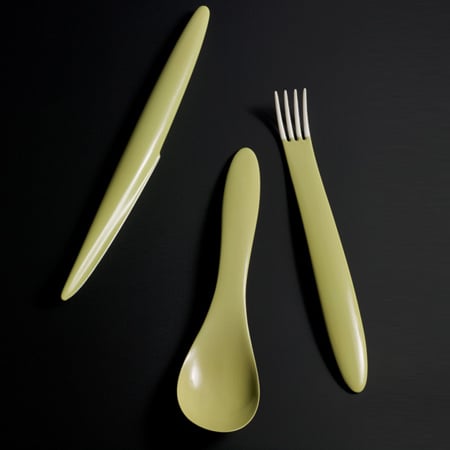Dutch designer Aldo Bakker has sent us images of his Urushi series of lacquered polyurethane objects.
Each object is coated in 60 layers of urushi, a traditional Japanese lacquer made of tree sap.
The series includes a side table and stools made of polyurethane foam coated in the lacquer, and a set of cutlery.
More about Aldo Bakker on Dezeen: Tableware
Photographs are by Erik & Petra Hesmerg except where stated otherwise.
Here's some more information from Bakker:
--
Urushi series
Side table
Our present society is characterized by a collectively imaginary lack of time. The pressure to succeed in our culture drives an ever-increasing search for the strangest kinds of relaxation and freedom.
The habituation to a high daily dose of stimulus creates a kind of false addiction: the idea that stress and stimulation can act as a form of relaxation that compensates and irons out the usual stress factors.
My designs are an attempt to encourage the opposite: they demand slowness and awareness, time and attention. The enormous investment of attention and care that bring my products to life only becomes visible after a considerable amount of time. The precision of form and materials will eventually lead to new uses and experiences of the content. I question the most common significance of products and thus also their use. In an ideal situation, every object takes on its own character and gains its own legitimacy. My designs are not based on fashion. They are unique pieces, not necessarily understandable at a glance, but meant for a slow, layer by layer exploration.
Vision
The above points to one conclusion: the ‘Urushi Series’ is primarily about sustainability. My vision of sustainability is mainly directed at influencing behaviour. My products represent a peaceful, silent protest against the way that consumer society has increasingly become only about the material. My answer is an effort to create products that are endlessly enduring and that point towards ‘eternal life.’ Conservation versus consumerism.
Form & Content
The combinations of materials in the Urusi side table are unique and very stimulating for me. My combinations create a bridge between traditional and industrial production, between the ultimate craftsmanship and the precision of computer-driven production methods. The extreme control of the finished product is the result on the one hand of years of practice and on the other of the translation of human behaviour into complex software. I can thus create (im-)possible combinations of the natural and the synthetic. The core, ‘the body’ of the side table is, for example, made from stiff PU foam. This means a structural reduction of necessary materials. Without additional (framed) construction forms, I am capable of achieving the desired shape. The material is exceptional for modelling, and offers great control over the (surprisingly light) weight of the finished product.
Above photograph is by Wouter van den Brink.
Result
I achieve the ‘everlastingness’ of the object by applying the Japanese ‘Urushi’ varnish. This varnish is completely naturally extracted from the Urushi tree and can be applied to the body almost directly. Urushi is applied in 60 layers, of which roughly 30 are for varnishing and the other 30 for polishing. This natural one-component varnish becomes harder and harder over time. Its combination with the stiff PU foam is extraordinary. The core remains a ‘dead’ material, so there is no chance of movement that could eventually mean a change in the varnish. One could imagine that a strong ‘display case’ of Urushi protects the ‘fragile perfection’ of the form and immortalizes this synthetic material. There are 9000-year-old objects that are still well preserved with Urushi.
Above photograph is by Wouter van den Brink.
I am strongly convinced that the value and beauty of Urushi is not tied to any particular phase or time. In fact, I see an enrichment of the age-old history and tradition of Urushi in these latest developments in materials, design and culture. For me, it represents the essence of the tradition: the encouragement and understanding of craft, technique or materials that have proven themselves over the centuries, and their application so that new insights emerge that might lead us towards the next step.
My design and fundamental cornerstones: awareness, time and attention are prerequisites for the use of Urushi varnish. It demands a very meticulous treatment and emphasizes the form, shadow, texture and colour of the object. The finish has an elusive, heavenly quality. No traces, a great depth and an almost unreal result. The beauty of the glow makes us momentarily forget our mortality all the while preserving the feeling that there is a great humanity to the finish.
I am collaborating with Urushi artist Mariko Nishide on the Urushi series. Together, we are trying to give the Urushi Craft a place on the international stage.
The Side table will be available in a limited edition of 7 pieces.

